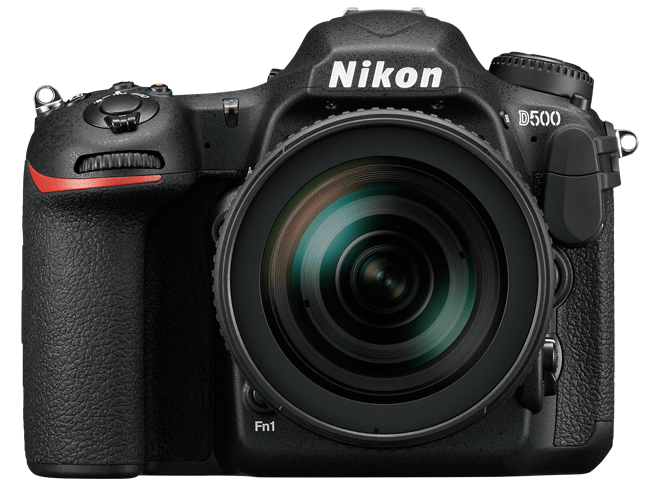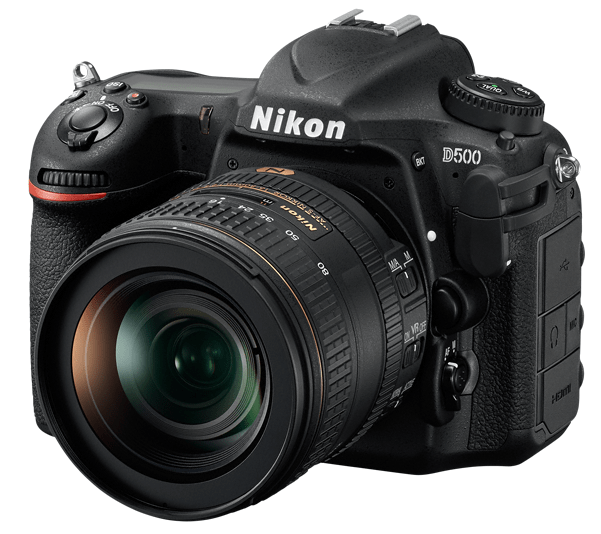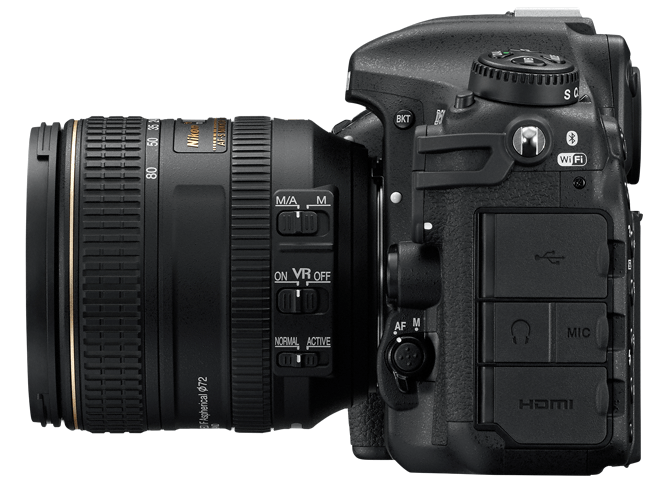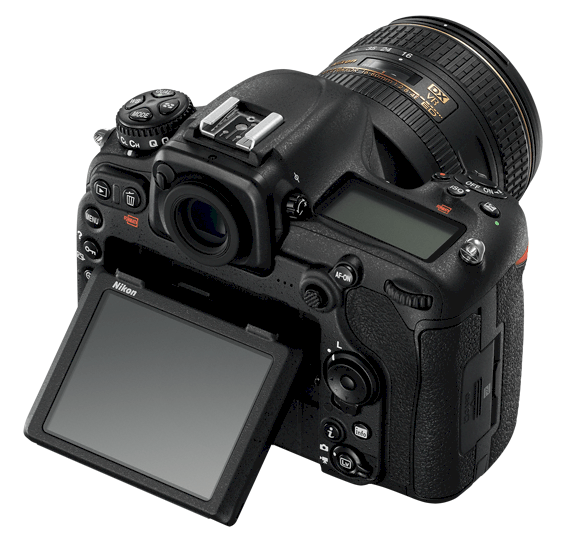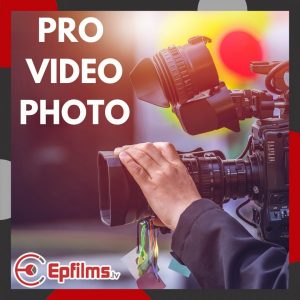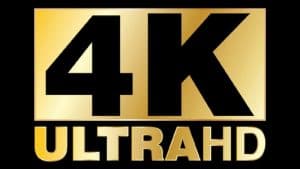Last Updated on June 30, 2020
Features
- 20.9MP DX format CMOS sensor
- EXPEED 5 image processor
- 4K UHD (3840x2160) at 30/25/24p
- Full HD (1,920x1,080) up to 60 fps
- ISO 100-51,200 (Expandable to 1,640,000)
- 10 FPS Continuous Shooting
- Multi-CAM 20K Autofocus sensor with 153/99 AF points
- 3.2-inch 2,359k-dot tilting RGB LCD touchscreen
- Wi-Fi, Bluetooth, NFC, SnapBridge functionality
Nikon D500 Introduction Video
Nikon D500 Overview
Nikon has come up with a new powerful camera that boasts of technological advances and versatility that will take you, the photography enthusiast, to where you want to go. Say hello to the DX flagship, Nikon D500. This new DX-line-leader is equipped with new features that will ensure high picture quality, resolution and speed.
Perfect for travelers, professionals and passionate people looking forward to capture great images and videos in different environments, whether in the suburban and city streets or the vast wilderness, users can really on the rugged design and new features of this robust DSLR.
Moreover, it comes with a tiltable touchscreen display in high resolution to make 4K UHD video playbacks more enjoyable. And with its built-in SnapBridge capabilities complete with WiFi and Bluetooth connection, sharing your files has never been this convenient.
Design and Features
The body of the Nikon D500 contains a number of features that makes it comparable to the expensive FX camera body which gives the user a feel similar to that of a professional camera, with its round eyepiece complemented by a built-in shutter. The rugged body of the D500 has dedicated buttons for ISO, metering mode, image quality and WB, among others. The buttons have a tactile feel and the integrated vertical grip makes it more manageable and portable. Being compact in design, this DSLR is also lightweight.
For its features, users who have previously owned Nikon cameras will agree that this camera has many enhanced features located in familiar places. If there is one feature perfect for FX owners, it is the 10-pin remote terminal that allows for FX body accessories, such as the cable release, to be plugged straight into the Nikon D500.
The Nikon D500 is equipped with 20.9 megapixel sensor and is capable of shooting up to 10 fps continuous shooting. As for its autofocus system, it has 153 point AF module with 99 cross-type points with 15 of this points can work with f/8 maximum aperture lens and teleconverter and can work down to -3EV (-4EV for the center point).
If paired with Nikkor lenses, this will be a great fit, such as the fast AF-S DX NIKKOR 16-80mm f/2.8-4E ED VR and the lightweight AF-S DX NIKKOR 55-200mm f/4-5.6G ED VR II which is suitable for shooting sports videos and other events and structures from a distance. Moreover, the AF module is linked to a 180,000 pixel RGB metering sensor that plays a significant role in enhancing the AF tracking capabilities of the camera. It also has two parameters that are useful to fine tune the tracking behavior of the AF. This makes it possible for the user to specify the type of the movement of the subject as well as aid in coming up with the correct response with regards to a blocking object, capabilities not found in previous Nikon models.
The Nikon D500 is powered by an EXPEED 5 processor which is capable of processing images faster that allows for capturing images continuously. Moreover, the camera is able to provide faster read/write transfer speeds because of the new XQD memory card technology and the dual memory card slots also allow SD cards to be read.
Other features of the Nikon D500 include an AF point joystick on top of a 2.36M-dot tilting touchscreen display, 4K (UHD) video from 1.5x crop of sensor, WiFi and Bluetooth connectivity with NFC, microphone and headphone sockets, USB 3.0 connector and 100% coverage viewfinder with 1.0x magnification.
Pros and Cons
The Nikon D500 is powerful despite having a compact body. It is also fast and boasts of excellent continuous shooting as well as autofocus performance. It also offers 4K video support given its price and its features have been improved. Even with an APS-C sensor, images are sharp and color rendering and white balance are excellent in quality.
As for the flaws, the Nikon D500 has few but these are just minor setbacks. It has a default Standard Picture Control that increases contrast that results to losing some details in highlights and shadows.
Conversely, midtones can be compressed. There is also a lot of noise in shadows that are above ISO 6400. Although the SnapBridge feature is distinct, the app can be disappointing at times and in terms of Live View contrast AF, it needs a little improvement.
Final Thoughts
Overall, the Nikon D500 is a powerful and compact DSLR that is a better version of its predecessor. With its new features and its price, this versatile camera offers potential owners a good deal. Not only does it boast of a rugged body design but also of enhanced features.
| Type | Single-lens reflex digital camera |
|---|---|
| Lens mount | Nikon F mount (with AF coupling and AF contacts) |
| Effective angle of view | Nikon DX format; focal length in 35 mm [135] format equivalent to approx. 1.5x that of lenses with FX format angle of view |
| Effective pixels | |
| Effective pixels | 20.9 million |
| Image sensor | |
| Image sensor | 23.5 x 15.7 mm CMOS sensor |
| Total pixels | 21.51 million |
| Dust-reduction system | Image sensor cleaning, Image Dust Off reference data (Capture NX-D software required) |
| Storage | |
| Image size (pixels) |
|
| File format |
|
| Picture Control system | Standard, Neutral, Vivid, Monochrome, Portrait, Landscape, Flat; selected Picture Control can be modified; storage for custom Picture Controls |
| Media | XQD, SD (Secure Digital) and UHS-II compliant SDHC and SDXC memory cards |
| Dual card slot | Either card can be used for primary or backup storage or for separate storage of NEF (RAW) and JPEG images; pictures can be copied between cards |
| File system | DCF 2.0, Exif 2.3, PictBridge |
| Viewfinder | |
| Viewfinder | Eye-level pentaprism single-lens reflex viewfinder |
| Frame coverage |
|
| Magnification | Approx. 1.0x (50 mm f/1.4 lens at infinity, -1.0 m-1) |
| Eyepoint | 16 mm (-1.0 m-1; from center surface of viewfinder eyepiece lens) |
| Diopter adjustment | -2 to +1 m-1 |
| Focusing screen | Type B BriteView Clear Matte Mark II screen with AF area brackets (framing grid can be displayed) |
| Reflex mirror | Quick return |
| Depth-of-field preview | Pressing Pv button stops lens aperture down to value selected by user (A and M modes) or by camera (P and S modes) |
| Lens aperture | Instant return, electronically controlled |
| Lens | |
| Compatible lenses | Compatible with AF NIKKOR lenses, including type G, E and D lenses (some restrictions apply to PC lenses) and DX lenses, AI-P NIKKOR lenses, and non-CPU AI lenses (A and M modes only); IX-NIKKOR lenses, lenses for the F3AF, and non-AI lenses cannot be used The electronic rangefinder can be used with lenses that have a maximum aperture of f/5.6 or faster (the electronic rangefinder supports 15 focus points with lenses that have a maximum aperture of f/8 or faster, of which 9 points are available for selection) |
| Shutter | |
| Type | Electronically controlled vertical-travel focal-plane mechanical shutter; electronic front-curtain shutter available in mirror up release mode |
| Speed | 1/8000 to 30 s in steps of 1/3, 1/2 or 1 EV, bulb, time, X250 |
| Flash sync speed | X=1/250 s; synchronizes with shutter at 1/250 s or slower |
| Release | |
| Release mode | S (single frame), CL (continuous low speed), CH (continuous high speed), Q (quiet shutter-release), QC (quiet continuous shutter-release), Self-timer, MUP (mirror up) |
| Approximate frame advance rate | CL: 1 to 9 fps, CH: 10 fps, QC: 3 fps |
| Self-timer | 2 s, 5 s, 10 s, 20 s; 1 to 9 exposures at intervals of 0.5, 1, 2 or 3 s |
| Exposure | |
| Metering | TTL exposure metering using RGB sensor with approx.180K (180,000) pixels |
| Metering method |
|
| Range (ISO 100, f/1.4 lens, 20°C/68°F) |
|
| Exposure meter coupling | Combined CPU and AI |
| Mode | Programmed auto with flexible program (P); shutter-priority auto (S); aperture-priority auto (A); manual (M) |
| Exposure compensation | -5 to +5 EV in increments of 1/3, 1/2 or 1 EV |
| Exposure lock | Luminosity locked at detected value |
| ISO sensitivity (Recommended Exposure Index) |
ISO 100 to 51200 in steps of 1/3, 1/2 or 1 EV; can also be set to approx. 0.3, 0.5, 0.7 or 1 EV (ISO 50 equivalent) below ISO 100 or to approx. 0.3, 0.5, 0.7, 1, 2, 3, 4 or 5 EV (ISO 1640000 equivalent) above ISO 51200; auto ISO sensitivity control available |
| Active D-Lighting | Auto, extra high, high, normal, low or off |
| Focus | |
| Autofocus | Multi-CAM 20K autofocus sensor module with TTL phase detection, fine-tuning, and 153 focus points (including 99 cross sensors and 15 sensors that support f/8), of which 55 (35 cross sensors and 9 f/8 sensors) are available for selection |
| Detection range | -4 to 20 EV (ISO 100, 20°C/68°F) |
| Lens servo |
|
| Focus point | 153 focus points, of which 55 or 15 are available for selection |
| AF-area mode | Single-point AF, 25-, 72-, or 153-point dynamic-area AF, 3D-tracking, group-area AF, auto-area AF |
| Focus lock | Focus can be locked by pressing shutter-release button halfway (single-servo AF) or by pressing the center of the sub-selector |
| Flash | |
| Flash control | TTL: i-TTL flash control using RGB sensor with approx. 180K (180,000) pixels; i-TTL balanced fill-flash for digital SLR is used with matrix, center-weighted and highlight-weighted metering, standard i-TTL fill-flash for digital SLR with spot metering |
| Flash mode | Front-curtain sync, slow sync, rear-curtain sync, red-eye reduction, red-eye reduction with slow sync, slow rear-curtain sync, off; auto FP high-speed sync supported |
| Flash compensation | -3 to +1 EV in increments of 1/3, 1/2 or 1 EV |
| Flash-ready indicator | Lights when optional flash unit is fully charged; flashes after flash is fired at full output |
| Accessory shoe | ISO 518 hot-shoe with sync and data contacts and safety lock |
| Nikon Creative Lighting System (CLS) |
i-TTL flash control, Advanced Wireless Lighting (optical/radio), auto FP high-speed sync, modeling illumination, FV lock, unified flash control, flash color information communication and AF-assist illumination for multi-point AF |
| Sync terminal | ISO 519 sync terminal with locking thread |
| White balance | |
| White balance | Auto (3 types), incandescent, fluorescent (7 types), direct sunlight, flash, cloudy, shade, preset manual (up to 6 values can be stored, spot white balance measurement available during live view), choose color temperature (2500 K to 10000 K), all with fine-tuning |
| Bracketing types | |
| Bracketing types | Exposure, flash, white balance, and ADL |
| Live view | |
| Live view mode | Photo live view, movie live view |
| Lens servo |
|
| AF-area mode | Face-priority AF, wide-area AF, normal-area AF, subject-tracking AF |
| Autofocus | Contrast-detect AF anywhere in frame (camera selects focus point automatically when face-priority AF or subject-tracking AF is selected) |
| Movie | |
| Metering | TTL exposure metering using main image sensor |
| Metering method | Matrix, center-weighted or highlight-weighted |
| Frame size (pixels) and frame rate |
Actual frame rates for 60p, 50p, 30p, 25p and 24p are 59.94, 50, 29.97, 25 and 23.976 fps respectively; ★high quality available at all frame sizes, normal quality available at all frame sizes except 3840 x 2160 |
| File format | MOV |
| Video compression | H.264/MPEG-4 Advanced Video Coding |
| Audio recording format | Linear PCM |
| Audio recording device | Built-in stereo or external microphone; sensitivity adjustable |
| ISO sensitivity |
|
| Active D-Lighting | Extra high, high, normal, low or off |
| Maximum length | 29 min. 59 s |
| Other movie options | Index marking, time-lapse movies, electronic vibration reduction |
| Monitor | |
| Monitor | 8-cm/3.2-in., approx. 2359k-dot (XGA) TFT ve LCD with 170° viewing angle, approx. 100% frame coverage, and manual monitor brightness control |
| Playback | |
| Playback | Full-frame and thumbnail (4, 9 or 72 images) playback with playback zoom, movie playback, photo and/or movie slide shows, histogram display, highlights, photo information, location data display, auto image rotation, picture rating and IPTC information embedding and display |
| Interface | |
| USB | SuperSpeed USB (USB 3.0 Micro-B connector); connection to built-in USB port is recommended |
| HDMI output | Type C HDMI connector |
| Audio input | Stereo mini-pin jack (3.5-mm diameter; plug-in power supported) |
| Audio output | Stereo mini-pin jack (3.5-mm diameter) |
| Ten-pin remote terminal | Can be used to connect optional remote control, WR-R10 (requires WR-A10 WR Adapter) or WR-1 Wireless Remote Controller, GP-1/GP-1A GPS Unit or GPS device compliant with NMEA0183 version 2.01 or 3.01 (requires MC-35 GPS Adapter Cord and cable with D-sub 9-pin connector) |
| Wireless | |
| Standards | IEEE 802.11b, IEEE 802.11g |
| Authentication | Open system, WPA2-PSK |
| Bluetooth | |
| Communication protocols | Bluetooth Specification Version 4.1 |
| NFC | |
| Operation | NFC Forum Type 3 Tag |
| Supported languages | |
| Supported languages |
Arabic, Bengali, Bulgarian, Chinese (Simplified and Traditional), Czech, Danish, Dutch, English, Finnish, French, German, Greek, Hindi, Hungarian, Indonesian, Italian, Japanese, Korean, Marathi, Norwegian, Persian, Polish, Portuguese (Portugal and Brazil), Romanian, Russian, Serbian, Spanish, Swedish, Tamil, Telugu, Thai, Turkish, Ukrainian, Vietnamese |
| Power source | |
| Battery | One EN-EL15 Rechargeable Li-ion Battery |
| Battery pack | Optional MB-D17 Multi-Power Battery Pack with one EN-EL18a or EN-EL18 Rechargeable Li-ion Battery (available separately), one EN-EL15 Rechargeable Li-ion Battery or eight R6/AA-size alkaline, Ni-MH or lithium batteries; a BL-5 Battery Chamber Cover is required when using EN-EL18a or EN-EL18 battery |
| AC adapter | EH-5b AC Adapter; requires EP-5B Power Connector (available separately) |
| Tripod socket | |
| Tripod socket | 1/4 in. (ISO 1222) |
| Dimensions / weight | |
| Dimensions (W x H x D) |
Approx. 147 x 115 x 81 mm/5.8 x 4.6 x 3.2 in. |
| Weight | Approx. 860 g/1 lb 14.4 oz with battery and XQD memory card but without body cap; approx. 760 g/1 lb 10.9 oz (camera body only) |
| Operating environment | |
| Operating environment | Temperature: 0 to 40°C/32 to 104°F humidity: 85% or less (no condensation) |
| Accessories | |
| Supplied accessories (may differ by country or area) |
EN-EL15 Rechargeable Li-ion Battery, MH-25a Battery Charger, DK-17F Fluorine-Coated Finder Eyepiece, UC-E22 USB Cable, USB Cable Clip, HDMI Cable Clip, AN-DC17 Camera Strap, BF-1B Body Cap |
Unboxing the Nikon D500
User Reviews
Submit your review | |
No products found.
